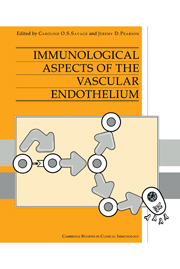Book contents
- Frontmatter
- Contents
- List of contributors
- Preface
- 1 New concepts of mechanisms in autoimmunity
- 2 Regulation of endothelial cell function by cytokines
- 3 Interactions between granulocytes and endothelium
- 4 The regulation of lymphocyte migration by vascular endothelium and its role in the immune response
- 5 Role of the vascular endothelium in immunologically mediated neurological diseases
- 6 The role of the endothelium in systemic lupus erythematosus and Sjögren's syndrome
- 7 The role of the endothelium in rheumatoid arthritis and scleroderma
- 8 The role of the endothelium in systemic vasculitis
- 9 Endothelial involvement in childhood Kawasaki disease
- 10 The role of the endothelium in thrombotic thrombocytopaenic purpura and haemolytic uraemic syndrome
- 11 The immunological role of the endothelium in organ transplantation
- Index
1 - New concepts of mechanisms in autoimmunity
Published online by Cambridge University Press: 04 August 2010
- Frontmatter
- Contents
- List of contributors
- Preface
- 1 New concepts of mechanisms in autoimmunity
- 2 Regulation of endothelial cell function by cytokines
- 3 Interactions between granulocytes and endothelium
- 4 The regulation of lymphocyte migration by vascular endothelium and its role in the immune response
- 5 Role of the vascular endothelium in immunologically mediated neurological diseases
- 6 The role of the endothelium in systemic lupus erythematosus and Sjögren's syndrome
- 7 The role of the endothelium in rheumatoid arthritis and scleroderma
- 8 The role of the endothelium in systemic vasculitis
- 9 Endothelial involvement in childhood Kawasaki disease
- 10 The role of the endothelium in thrombotic thrombocytopaenic purpura and haemolytic uraemic syndrome
- 11 The immunological role of the endothelium in organ transplantation
- Index
Summary
Introduction
Autoimmune diseases are, by definition, ones in which pathology results directly or indirectly from specific immune recognition of self-tissues. Although the ultimate mediators of destruction may include T cells, antibody and complement or activated macrophages, attention has focused on the central interaction of antigenic peptide, major histocompatibility complex (MHC) molecule and T cell receptor (TCR) needed to trigger recognition. The paradigm for analysis of these events has come largely from studies in a small number of mouse and rat models. In particular, experimental allergic encephalomyelitis (EAE), an experimentally induced disease where animals show CNS inflammation sometimes including demyelination, is a model for some aspects of multiple sclerosis (MS), while the non-obese diabetic (NOD) mouse offers a good model for the spontaneous, autoimmune destruction of pancreatic beta cells in insulin dependent, type I diabetes (IDDM).
Experiments in such models have raised the hope that characterization of the molecular components involved in the activation of autoreactive T cells will pave the way for the design of highly selective immunosuppressive therapies. Since the stimulation of specific T cells to kill targets or secrete cytokines depends on signals which follow precise binding of the TCR to a complex formed by antigenic peptide lodged in the ‘cleft’ of a specific MHC molecule, therapeutic intervention may be offered by competition with, or blocking of, any of these compounds. Indeed, many major pharmaceutical companies currently base much of their research and development for diseases such as rheumatoid arthritis and diabetes on this premise.
- Type
- Chapter
- Information
- Immunological Aspects of the Vascular Endothelium , pp. 1 - 19Publisher: Cambridge University PressPrint publication year: 1995



